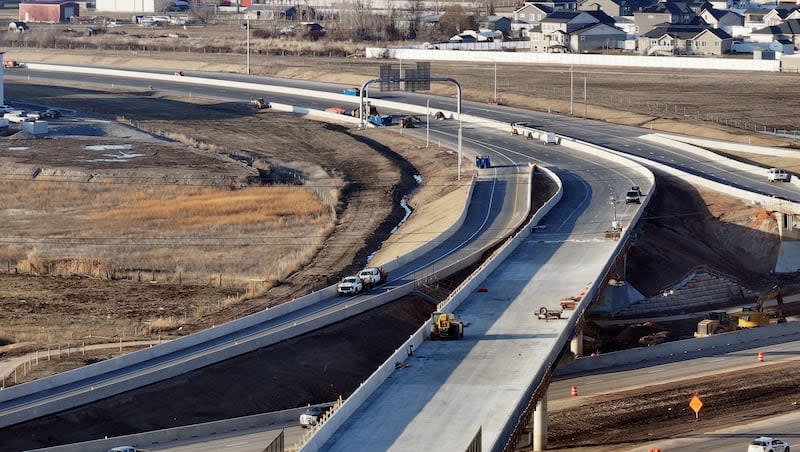Stuart Adams: How Utah is looking 100 years ahead

- Oops!Something went wrong.Please try again later.
If you have ever taken a drive-up Highway 89 toward Ogden and caught sight of the picturesque small reservoirs dotting the west side, you may have noticed Holmes Reservoir, a historic landmark marking one of the first reservoirs in Utah and potentially the entire Mountain West. Built by my great-great-great grandfather Elias Adams and his sons, it holds a significant place in my family’s legacy. As a proud fifth generation Utahn, I often reflect on how Holmes Reservoir continues to serve the community of Layton and Kaysville even after more than 150 years.
Utahns’ inclination toward long-term planning isn’t entirely unexpected. Rooted in a heritage tracing back to the early pioneers who settled here in the 1840s, we’ve always fostered a deep-seated desire to safeguard and enhance this land for the benefit of generations to come.
For many of us, we tend to look to the future in the short term: tomorrow, next week, perhaps six months ahead or even five years down the line. Envisioning beyond a few years can be challenging. Yet, as elected officials, it’s incumbent upon us to focus not only on the present moment but to cast our gaze forward, envisioning the world a century away, long after we’ve left our posts.
That has been the focus this past legislative session — to think generationally about how to best prepare our state for long-term success. Generational planning is more than balancing budgets or enacting policies for the here and now. It’s about envisioning the kind of state we want to leave for our children and grandchildren — a state that is sustainable, resilient and even better than we have it today.
This thoughtful planning requires us to consider what our state will require 100 years from now. What kind of transit infrastructure, water resources and energy will the state need to support a much larger population?
Water is one of Utah’s lifelines. Without it, our landscape could not sustain nearly as many Utahns. The foresight of pioneers who planned and constructed reservoirs and water infrastructure was revolutionary. We must adopt a similar forward-thinking approach when managing our water resources.

To address Utah’s long-term need for adequate and reliable water, I ran SB211 this session to create the Water District Water Development Council and a Utah Water Agent to plan for and develop generational water infrastructure projects that look 75-100 years into the future. They will report their project ideas and findings to the Legislature, where policy can be formed and debated.
Utah is expected to have the lowest electric energy rates in the nation this year. Energy prices play a pivotal role in driving a robust economy, so it is evident that we need to sustain this momentum of reliable, affordable and sustainable energy. This legislative session, we passed bills to strengthen an “all-of-the-above approach” to energy and develop a comprehensive long-term energy strategy so that prices remain low for decades.
Ensuring Utah’s long-term competitiveness requires exploring avenues to empower Utahns to keep more of their hard-earned money. Over the past four years, the Utah Legislature has reduced taxes by more than 1.3 billion. This session, we cut income taxes again by $170 million — again, again, again and again. Lowering the income tax is the fairest way to reduce the tax burden for Utahns and promote upward mobility.
Utah is an incredibly desirable place to live. From cultivating the strongest economy in the nation to our beautiful natural landscapes and family-friendly communities, people from all over are taking notice and moving to Utah. However, with this influx comes the pressing issue of housing affordability. To jump-start more homeownership in the state, we are actively promoting innovative policies to expand the housing market with more single-family starter homes and ensure accessibility for all. I hope all 16 of my grandchildren will be able to purchase their own starter homes in Utah as adults. We need to strive for housing solutions so that owning a home is not a dream of the past.
Reflecting on the transformation of Layton and Kaysville, my ancestors who settled there would likely be astonished by the city’s evolution. Once a small community perched up along the Wasatch Front, it is now a bustling town with vibrant neighborhoods and prosperous businesses. My ancestors and countless other first-generation Utahns from the pioneer era maintained a forward-looking perspective. They worked to ensure the land was prosperous for their kids and grandkids’ futures.
While they could not predict the future, their values and principles guided them toward creating a vibrant state of family-friendly communities and hard-working citizens. The Utah we know today was dreamt up by visionaries of the previous generations. Now, we are in charge of dreaming and planning our way into the future while still focusing on what we can do to improve Utahns’ lives today. As we contemplate the future, it’s daunting to envision Utah a century from now, when the population will likely surpass 12 million. Nonetheless, it’s important for us to embrace the challenge to foresee the obstacles ahead and work toward establishing enduring prosperity.
J. Stuart Adams is the Utah senate president.

